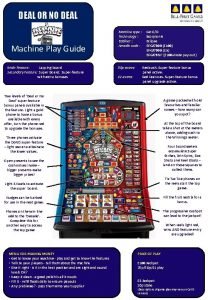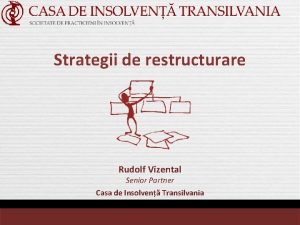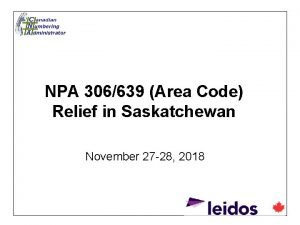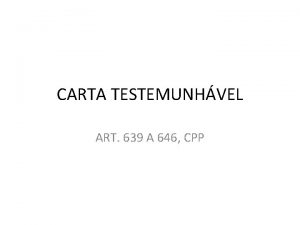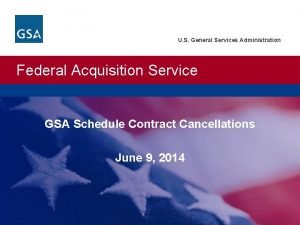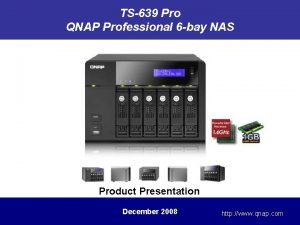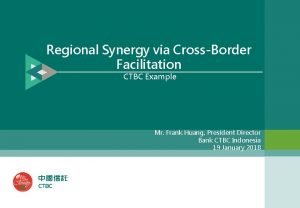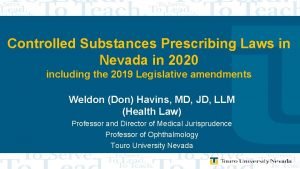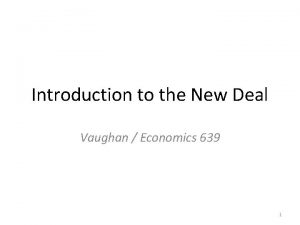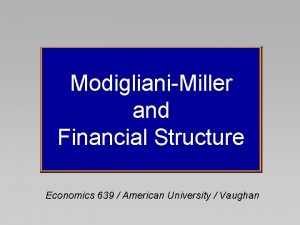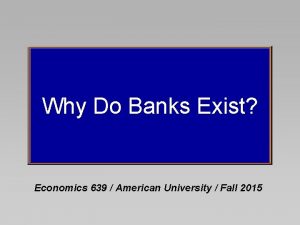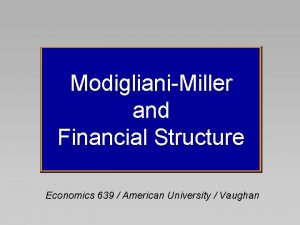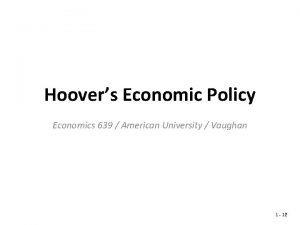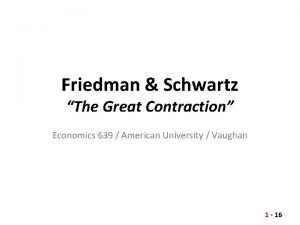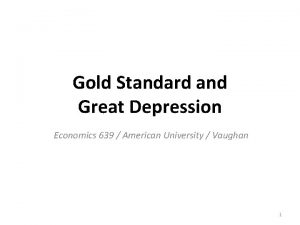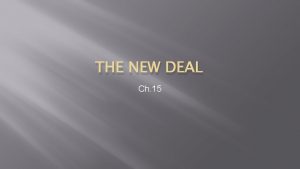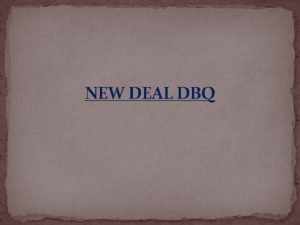Introduction to New Deal Economics 639 American University











- Slides: 11

Introduction to New Deal Economics 639 / American University / Vaughan 1

New Deal • Domestic programs enacted between 1933 and 1938 under leadership of President Franklin D. Roosevelt (FDR). • Historians distinguish between first and second New Deal: – First, 1933– 34 (includes “ 100 Days”) – Second, 1935– 38 more “liberal” (i. e. , social-justice focus) and controversial. • Consensus of economic literature is most “recovery” programs ineffective or counterproductive (more later) • Many historians (David Kennedy, Stanford) believe FDR placed social reform above economic recovery 2 - 11

Key Parts of First New Deal (from Macro/Finance Perspective) • Bank Holiday (1933) • Suspension of Gold Standard (1933 -34) • Glass Steagall Act (1933) – Separation of commercial / investment banking – Creation of FDIC (Federal deposit insurance) • Securities and Exchange Commission (1934) • Tennessee Valley Authority (1933) • Other Jobs/Public Works Programs – Civilian Conservation Corps (1933) – Public Works Administration (1933) • Agricultural Adjustment Act (1933) • National Industrial Recovery Act (1933) Later struck down by Supreme Court 3 - 11

Key Parts of Second New Deal (from Macro/Finance Perspective) • Social Security Act (1935) – Social Security • Payroll taxes started 1937; benefits first paid 1940 – Unemployment Compensation – Aid to Dependent Children • Banking Act of 1935 – Reorganized Federal Reserve • National Labor Relations Act (Wagner Act, 1935) • Works Progress Administration (1935) • Fair Labors Standards Act (1938) – Included Federal minimum wage • Tax Hikes – Increased progressivity of income tax (1935) – Undistributed corporate profits tax (1936) 4 - 11

Closing Thoughts FDR not Keynesian • General Theory not published until 1936. • Remained committed to budget balancing (though it not as important as other goals). • AD stimulus from 1930 s deficits insufficient (more later) 5 - 11

Closing Thoughts Continued Why did return to trend take so long (1941/42)? • “Pro” New Deal Economists: ‒ Initial AD shock large and contraction deep ‒ Fiscal stimulus virtually nonexistent ‒ Fed doubling of reserve requirements and tax increases interrupted recovery with 1937 -38 “Roosevelt Recession” (AD↓). • “Anti” New Deal Economists: ‒ “Frictions” from New Deal policies slowed / stymied recovery (AS↓). ‒ Uncertainty (about policy, property rights) added drag (AD↓, AS↓). Consensus: All played role, except lack of stimulus (under debate). Recent research has focused on aggregate supply “drag” from New Deal policies. 6 - 11

Closing Thoughts FDR Economic Policy Successes • Bank Holiday / Licensing – Restored confidence in banking system • Creating FDIC – Permanently ended “runs” and attendant collapse of money supply. • Leaving Gold Standard • Creating SEC • Jobs Programs / Public Works (? ) 7 - 11

Impact of New Deal Jobs Programs Difference between blue and red lines is impact of New Deal jobs programs. 8 - 11

Closing Thoughts FDR Economic Policy Failures • National Industrial Recovery Act – Promoted higher prices/wages and lower output when GDP needed to grow and prices/wages needed to be flexible. • Banking Act of 1935 – Gave newly created Board of Governors power to set reserve requirements (used disastrously in 1936 -37). • “Atmospherics” – anti-business/anti-wealthy rhetoric, frenetic introduction/abandonment of new policies, Supreme Court Packing, etc. – Created policy uncertainty and insecurity about property rights. 9 - 11

Closing Thoughts FDR Economic Policy Failures • Agricultural Adjustment Act – Paid farmers not to produce when people were hungry. • Glass Steagall – Kept commercial and investment banks from exploiting economies of scope. – Put U. S. commercial banks at competitive disadvantage relative to banks in Europe and Japan. • Miscellaneous AD/AS “Drag” – Tax increases – Labor unrest following Wagner Act – Introduction of Federal minimum wage. 10 - 11

Final Points • Economic policies labeled successes or failures mostly based solely on short-term contribution to recovery. • Some “failures” successes from long-term, socialjustice standpoint. – Social Security, for example • Some “successes” caused major problems later. – Moral hazard in deposit insurance ultimately cost federal government billions in 1980 s. 11 - 11
 Deal or no deal machine
Deal or no deal machine Rudolf vizental
Rudolf vizental Maastricht university economics and business economics
Maastricht university economics and business economics Definisie van n pa
Definisie van n pa Art 639 cpp
Art 639 cpp I-fss-639
I-fss-639 Qnap ts 639 pro
Qnap ts 639 pro Ctbc 639
Ctbc 639 Nevada controlled substance list
Nevada controlled substance list Almost everyone fails to pass the driver's test
Almost everyone fails to pass the driver's test How to deal with university stress
How to deal with university stress Vocabulary review causes of the depression
Vocabulary review causes of the depression
